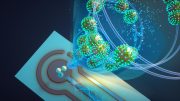
This graphic art illustrates the lithium-mediated conversion of N2 to ammonia. Pictured is a symphony of reactions occurring on an electrodeposited lithium (black tiles). Under high pressure, nitrogen (addition of blue blocks) is chemisorbed on lithium, followed by protonation (addition of white blocks) to form NHx, eventually leading to ammonia and the recovery of lithium. The cyclic process creates a catalytic rhythm producing ammonia. This research highlights the significance of pressure and potential in controlling the structure and stability of the solid-electrolyte interface toward ammonia synthesis. Credit: Crystal Price & Joseph Gauthier, Texas Tech University; Meenesh Singh, University of Illinois Chicago
Low temperature, regenerative method conserves energy and effectively generates common chemical.
Among the many chemicals we use every day, ammonia is one of the worst for the atmosphere. The nitrogen-based chemical used in fertilizer, dyes, explosives, and many other products ranks second only to cement in terms of carbon emissions, due to the high temperatures and energy needed to manufacture it.
But by improving on a well-known electrochemical reaction and orchestrating a “symphony” of lithium, nitrogen, and hydrogen atoms, the University of Illinois Chicago engineers led by Meenesh Singh have developed a new ammonia production process that meets several green targets.
The process, called lithium-mediated ammonia synthesis, combines nitrogen gas and a hydrogen-donating fluid such as ethanol with a charged lithium electrode. Instead of cracking apart nitrogen gas molecules with high temperature and pressure, nitrogen atoms stick to the lithium, then combine with hydrogen to make the ammonia molecule.
The reaction works at low temperatures, and it’s also regenerative, restoring the original materials with each cycle of ammonia production.
The Science Behind the Process
“There are two loops that happen. One is the regeneration of the hydrogen source and the second is the regeneration of the lithium,” said Singh, associate professor of chemical engineering at UIC. “There is a symphony in this reaction, due to the cyclic process. What we did was understand this symphony in a better way and try to modulate it in a very efficient way, so that we can create a resonance and make it move faster.”
The process, described in a paper published and featured on the cover of ACS Applied Materials & Interfaces, is the latest innovation from Singh’s lab in the quest for cleaner ammonia. Previously, his group developed methods to synthesize the chemical using sunlight and wastewater and created an electrified copper mesh screen that reduces the amount of energy needed to make ammonia.
Their latest advance is built on a reaction that is hardly new. Scientists have known about it for nearly a century.
“The lithium-based approach can actually be found in any organic chemistry textbook. It’s very well-known” Singh said. “But making this cycle run efficiently and selectively enough to meet economically feasible targets was our contribution.”
Those targets include high energy efficiency and low cost. If scaled up, the process would produce ammonia at roughly $450 per ton, which is 60% cheaper than prior lithium-based approaches and other proposed green methods, according to Singh.
But selectivity is also important, as many attempts to make ammonia production cleaner have ended up creating large quantities of unwanted hydrogen gas instead.
Environmental Benefits and Hydrogen Fuel Potential
The Singh group’s results are among the first to achieve levels of selectivity and energy use that could meet Department of Energy standards for industrial-scale production of ammonia. Singh also said the process, which can be performed in a modular reactor, can be made even greener by powering it with electricity from solar panels or other renewable sources and feeding the reaction with air and water.
The process also could help meet another energy goal — the use of hydrogen as fuel. Reaching that goal has been stymied by the difficulties of transporting the highly combustible liquid.
“You want hydrogen to be generated, transported, and delivered to hydrogen pumping stations, where hydrogen can be fed to the cars. But it’s very dangerous,” Singh said. “Ammonia could function as a carrier of hydrogen. It’s very cheap and safe to transport, and at the destination, you can convert ammonia back to hydrogen.”
Currently, the scientists are partnering with the General Ammonia Co. to pilot and scale up their lithium-mediated ammonia synthesis process at a plant in the Chicago area. UIC’s Office of Technology Management has filed a patent for the process.
Reference: “Pathway toward Scalable Energy-Efficient Li-Mediated Ammonia Synthesis” by Nishithan C. Kani, Ishita Goyal, Joseph A. Gauthier, Windom Shields, Mitchell Shields and Meenesh R. Singh, 20 March 2024, ACS Applied Materials & Interfaces.
DOI: 10.1021/acsami.3c19499
The research was funded by grants from General Ammonia Co. Co-authors of the paper are Nishithan C. Kani and Ishita Goyal of UIC, Joseph A. Gauthier of Texas Tech University and Windom Shields and Mitchell Shields of General Ammonia Co.









A few issues:
This process uses lithium. Isn’t that a rare(ish) material that’s causing procurement challenges already?
“ended up creating large quantities of unwanted hydrogen gas instead” – pretty sure that’s “wanted.” Just because something is a byproduct shouldn’t mean it is waste. Seems like one of the most frustrating aspects of industry is the single-mindedness of process; if gold were the “large quantity,” it is highly likely it would have been seen as serendipitious.
When articles say, for instance, that a “new, improved” method can produce material for, say, “$450 at ton,” it would be ~absolutely~ relevant to give the price of production for other, current methods.
SciTech is a daily skim for me. Better journalism would keep my eyes here longer.
Cheers!